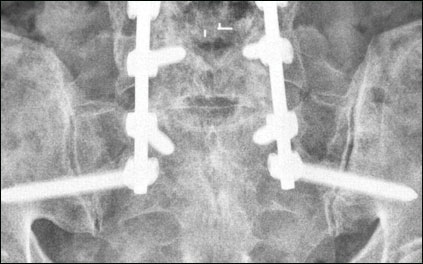Study shows S2 alar iliac screws led to high L5-S1 fusion, low partial perilucency rates
Although S2 alar iliac screws and iliac bolts both improved fusion rates when they were used for lumbopelvic fixation, the S2 alar iliac screws were associated with fewer wound-related complications and reoperations, according to findings of a retrospective study.
When S2 alar iliac (S2AI) screws or iliac bolts are used they can both help increase fusion rates of the lumbosacral junction, especially in patients who may be at high risk of a nonunion. However, according to a presentation by Marcus D. Mazur, MD, the S2AI screws have several advantages over the iliac bolts.
“We found the use of S2AI screws may improve the fusion rates of L5-S1 in patients who may be at high risk for nonunion. After about 2 years, the S2AI screws maintain their integrity and do not increase the morbidity of the patient despite crossing the SI joint,” Mazur said.
He conducted the study with Andrew T. Dailey, MD.
More reoperations with iliac bolts
Mazur and colleagues retrospectively reviewed the medical records of 60 patients who underwent lumbopelvic fixation with either S2AI screws or iliac bolts between December 2009 and March 2012. Twenty-three patients received S2AI screws and 37 patients received iliac bolts. The mean follow-up was 22 months.
The investigators analyzed patients’ medical records to identify clinical failures and compared the characteristics of patients who required a reoperation with those who did not need a reoperation via univariate, multivariate and survival analyses.

Image: Mazur MD
Based on the study results, reoperation rates were higher in patients who received iliac bolts compared with S2AI screws; (13 patients vs. 2 patients, respectively). A Kaplan-Meier analysis showed a failure-free rate of 96.6% from the time of the initial placement of lumbopelvic instrumentation to the 6-month follow-up. At the 1 year and 2 year follow-up time points, the failure free rates were 87% and 73.5%, respectively.
The univariate analysis revealed risk factors for an unplanned reoperation were the use of iliac bolts, absence of L5-S1 interbody graft, previous lumbar fusion and pathology other than degenerative disease and scoliosis. After the investigators adjusted for those risk factors, they found from the multivariate analysis the use of S2AI screws was the only independent predictor for the prevention of unplanned reoperations.
S2AI screws are well-tolerated
In a follow-up study, the investigators evaluated the radiographic outcomes of S2A1 screws in 13 patients who had CT scans preoperatively and at 12 months or more postoperatively. The mean follow-up was 24 months.
Partial peri-screw lucency was identified in seven S2AI screws (27%). Four patients with screw loosening had an osseous L5-S1 fusion, Mazur told Spine Surgery Today. L5-S1 nonunion was seen in 1 patient who had bilateral S2AI screw loosening in the sacrum.
No patients developed fusion across the sacroiliac joint or developed screw back out or breakage. In addition, no patients needed a reoperation or developed wound- or instrument-related complications due to the S2AI screws, Mazur noted. Therefore, he concluded, the low profile of the S2AI screws and the fact they cross three cortical surfaces may confer additional advantages over the use of iliac bolts and they may be better tolerated. – by Robert Linnehan
- References:
- Mazur MD, et al. J Neurosurg Spine. 2015;doi:10.3171/2014.10.SPINE14541.
- Mazur MD, et al. Paper #31. Presented at: Lumbar Spine Research Society Annual Meeting; April 9-10, 2015; Chicago.
- For more information:
- Marcus D. Mazur, MD, can be reached at Department of Neurosurgery, University of Utah, 175 N. Medical Dr. #5, Salt Lake City, UT 84132; email: marcus.mazur@hsc.utah.edu.
Disclosure: Mazur reports no relevant financial disclosures.
